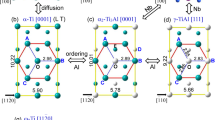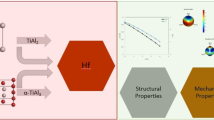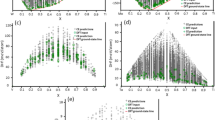Abstract
Titanium alloys are composed of α and β phases and are classified as near α, dual-phase α+β, and β types. This study attempts to derive their general composition formulas within the cluster-plus-glue-atom model by interpreting Ti-6Al-4V and other popular dual-phase α+β Ti alloys with well-established chemical compositions. Our model identified a molecule-like structural unit that covers only a nearest-neighbor cluster along with a few next-neighbor glue atoms, which can be represented as “[cluster](glue atoms)x”. The structural units of the α and β phases in Ti-6Al-4V, α-[Al-Ti12](AlTi2), and β-[Al-Ti14](V2Ti), were derived first and were in an unusual unit ratio of about 2.33:1. To obtain an alloy composition formula that satisfied this unit ratio, the two clusters were treated as hard spheres of different radii and packed according to the cluster-plus-glue-atom model. Our calculations determined that the Ti-6Al-4V alloy unit is composed of 12 α-[Al-Ti12](AlTi2) and 5 β-[Al-Ti14](V2Ti) units (Ti-6.05Al-3.94V wt.%), with the fractional volume of the β phase being 32.5 vol.%, which is in agreement with experimental data. Finally, we describe how the chemical formulas of the α and β phases explain the high temperature near-α alloys (such as Ti-1100, [Al-(Ti0.97Zr0.03)12](Al0.67Si0.12Sn0.18Mo0.03)1.01Ti1.99) and high-strength β-Ti alloys (such as Ti-5553, [Al-Ti14](Al0.24Fe0.03Cr0.20-Mo0.18V0.35)2.45Ti0.55), respectively.
Similar content being viewed by others
References
Froes F H. In Titanium-Physical Metallurgy, Processing, and Applications. Cleveland: ASM International Ltd., 2015
Morita T, Hatsuoka K, Iizuka T, et al. Strengthening of Ti-6Al-4V alloy by short-time duplex heat treatment. Mater Trans, 2005, 46: 1681–1686
Banerjee D, Williams J C. Perspectives on titanium science and technology. Acta Mater, 2013, 61: 844–879
Liu S, Shin Y C. Additive manufacturing of Ti6Al4V alloy: A review. Mater Des, 2019, 164: 107552
Williams J C, Starke Jr. E A. Progress in structural materials for aerospace systems. Acta Mater, 2003, 51: 5775–5799
Warwick J L W, Jones N G, Bantounas I, et al. In situ observation of texture and microstructure evolution during rolling and globularization of Ti-6Al-4V. Acta Mater, 2013, 61: 1603–1615
Liu Y, Qu Z D, Wang B X. Research development and application of Ti6Al4V alloy (in Chinese). Ord Mater Sci Eng, 2005, 25: 53–56
Lin X, Huang W D. Laser additive manufacturing of high-performance metal components (in Chinese). Sci Sin Inform, 2015, 45: 1111–1126
Mardaras J, Emile P, Santgerma A. Airbus approach for FDT stress justification of additive manufacturing parts. Procedia Struct Integrity, 2017, 7: 109–115
Boyer R R. An overview on the use of titanium in the aerospace industry. Mater Sci Eng A, 1996, 213: 103–114
Tian G M, Hong Q, Zhang L, et al. Titanium alloys applied for large civil airliner abroad (in Chinese). Titanium Ind Prog, 2008, 25: 24–27
Li L, Sun J K, Meng X J. Application state and prospects for titanium alloys (in Chinese). Titanium Ind Prog, 2004, 21: 9–24
Murr L E, Quinones S A, Gaytan S M, et al. Microstructure and mechanical behavior of Ti-6Al-4V produced by rapid-layer manufacturing, for biomedical applications. J Mech Behav Biomed Mater, 2009, 2: 20–32
Long M, Rack H J. Titanium alloys in total joint replacement—A materials science perspective. Biomaterials, 1998, 19: 1621–1639
Peng X, Guo H, Wang T, et al. Effects of β treatments on microstructures and mechanical properties of TC4-DT titanium alloy. Mater Sci Eng A, 2012, 533: 55–63
Niinomi M, Kobayashi T, Sasaki N. Toughness and microstructural factors of Ti-6Al-4V alloy. Mater Sci Eng, 1988, 100: 45–55
Gutierrez A, Hahn M, Li Y J, et al. The effect of different annealing conditions on the anisotropy of the fracture toughness of Ti-6Al-4V. J Materi Eng Perform, 2019, 28: 7155–7164
Mishin Y, Herzig C. Diffusion in the Ti-Al system. Acta Mater, 2000, 48: 589–623
Liang E Q, Huang S S, Ma Y J. The influence of Fe on the mechanical properties of Ti-6Al-4V ELI alloy. Chin J Mater Res, 2016, 30: 299–306
Sacristan I, Garay A, Hormaetxe E, et al. Influence of oxygen content on the machinability of Ti-6Al-4V alloy. Int J Adv Manuf Technol, 2016, 86: 2989–3005
Fan Y, Cao J, Yang H, et al. Effect of oxygen content and working on microstructural evolution and mechanical properties of biomedical Ti-6Al-4V alloy wire. In: Proceedings of the 12th World Conference on Titanium. Beijing, 2012. 477–480
Bordji K, Jouzeau J Y, Mainard D, et al. Cytocompatibility of Ti-6Al-4V and Ti-5Al-2.5Fe alloys according to three surface treatments, using human fibroblasts and osteoblasts. Biomaterials, 1996, 17: 929–940
Khan M A, Williams R L, Williams D F. The corrosion behaviour of Ti-6Al-4V, Ti-6Al-7Nb and Ti-13Nb-13Zr in protein solutions. Biomaterials, 1999, 20: 631–637
Paul J, Ania B. High strength alpha-beta titanium alloy. USA patent, US4943412, 1990-07-24
William W. Method of making low cost Ti-6Al-4V ballistic alloy. USA patent, US5332545, 1994-11-10
Hideaki K, Akira N, Naoya K. High strength and high ductility titanium alloy. USA patent, US5759484, 1998-06-02
Steven H R, John E K, James F M. Titanium-aluminum-vanadium alloys and products made using such alloys. USA patent, US60553993, 2000-04-25
Cowley J M. An approximate theory of order in alloys. Phys Rev, 1950, 77: 669–675
Cowley J M. Short- and long-range order parameters in disordered solid solutions. Phys Rev, 1960, 120: 1648–1657
Dong C, Wang Q, Qiang J B, et al. From clusters to phase diagrams: Composition rules of quasicrystals and bulk metallic glasses. J Phys D-Appl Phys, 2007, 40: 273–291
Dong D, Zhang S, Wang Z, et al. Nearest-neighbor coordination polyhedral clusters in metallic phases defined using Friedel oscillation and atomic dense packing. J Appl Crystlogr, 2015, 48: 2002–2005
Wang Q, Ji C, Wang Y, et al. β-Ti alloys with low young’s moduli interpreted by cluster-plus-glue-atom model. Metall Mat Trans A, 2013, 44: 1872–1879
Che J D, Jiang B B, Wang Q, et al. Effect of minor additions of elements into Ti1100 on elevated temperature oxidation- and corrosion-resistance (in Chinese). Rare Metal Mat Eng, 2018, 47: 1471–1477
Dong C, Dong D D, Wang Q. Chemical units in solid solutions and alloy composition design. Acta Metall Sin, 2018, 54: 293–300
Dong C, Wang Z J, Zhang S, et al. Review of structural models for the compositional interpretation of metallic glasses. Int Mater Rev, 2019, 65: 286–296
Jiang B, Wang Q, Dong C, et al. Exploration of phase structure evolution induced by alloying elements in Ti alloys via a chemical-short-range-order cluster model. Sci Rep, 2019, 9: 3404
Zhang S, Dong C. Dual-cluster interpretation of binary eutectics associated with hexagonal close-packed solid solution phases. Mater Lett, 2018, 233: 71–73
Takeuchi A, Inoue A. Classification of bulk metallic glasses by atomic size difference, heat of mixing and period of constituent elements and its application to characterization of the main alloying element. Mater Trans, 2005, 46: 2817–2829
Pang C, Jiang B, Shi Y, et al. Cluster-plus-glue-atom model and universal composition formulas [cluster](glue atom)x for BCC solid solution alloys. J Alloys Compd, 2015, 652: 63–69
Elmer J W, Palmer T A, Babu S S, et al. In situ observations of lattice expansion and transformation rates of α and β phases in Ti-6Al-4V. Mater Sci Eng A, 2005, 391: 104–113
Kim J H, Semiatin S L, Lee Y H, et al. A self-consistent approach for modeling the flow behavior of the alpha and beta phases in Ti-6Al-4V. Metall Mat Trans A, 2011, 42: 1805–1814
Semiatin S L, Knisley S L, Fagin P N, et al. Microstructure evolution during alpha-beta heat treatment of Ti-6Al-4V. Metall Mat Trans A, 2003, 34: 2377–2386
Fan Y, Tian W, Guo Y, et al. Relationships among the microstructure, mechanical properties, and fatigue behavior in Thin Ti6Al4V. Adv Mater Sci Eng, 2016, 2016: 1–9
Zhou M H. Effect of recrystallization annealing on properties of TC4 alloy sheet (in Chinese). Spec Steel Technol, 2008, 14: 15–18
Sun H, Liang Y L, Zhang H F, et al. Effect of recrystallization annealing temperatures on microstructures and mechanical properties of severe plastic thermo-deformation processed Ti-6Al-4V alloy (in Chinese). Rare Metal Mat Eng, 2019, 48: 3015–3021
Lonardelli I, Gey N, Wenk H R, et al. In situ observation of texture evolution during α→β and β→α phase transformations in titanium alloys investigated by neutron diffraction. Acta Mater, 2007, 55: 5718–5727
Tan Y Q. The effect of heat treatment on microstructure and mechanical properties of TC4 titanium and the research on stress relief after heat treatment (in Chinese). Dissertation for Master’s Degree. Chongqing: Chongqing University, 2016
Mao J H, Yang X K, Luo B L, et al. Effect of heat treatment temperature on microstructure and mechanical properties of TC4ELI alloy (in Chinese). Heat Treat Metals, 2020, 45: 171–179
Wang Q, Dong C, Liaw P K. Structural stabilities of β-Ti alloys studied using a new mo equivalent derived from [β/(α+β)] phaseboundary slopes. Metall Mat Trans A, 2015, 46: 3440–3447
Bania P J. Beta titanium alloys and their role in the titanium industry. JOM, 1994, 46: 16–19
Author information
Authors and Affiliations
Corresponding authors
Additional information
This work was supported by the National Key Research and Development Program of China (Grant No. 2016YFB1100103), the Science Research Project of Liaoning Province Education Department (Grant No. JDL2019023), the Natural Science Foundation of Liaoning Province (Grant No. 2020-BS-208), and the Open Project of Key Laboratory of Materials Modification by Laser, Ion and Electron Beams (Grant No. KF2006).
Rights and permissions
About this article
Cite this article
Liu, T., Zhang, S., Wang, Q. et al. Composition formulas of Ti alloys derived by interpreting Ti-6Al-4V. Sci. China Technol. Sci. 64, 1732–1740 (2021). https://doi.org/10.1007/s11431-020-1812-9
Received:
Accepted:
Published:
Issue Date:
DOI: https://doi.org/10.1007/s11431-020-1812-9




